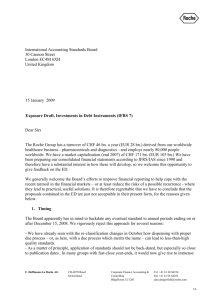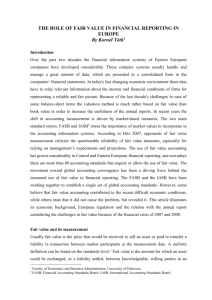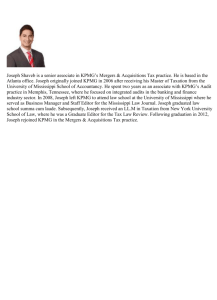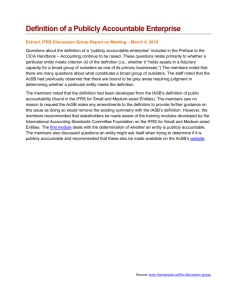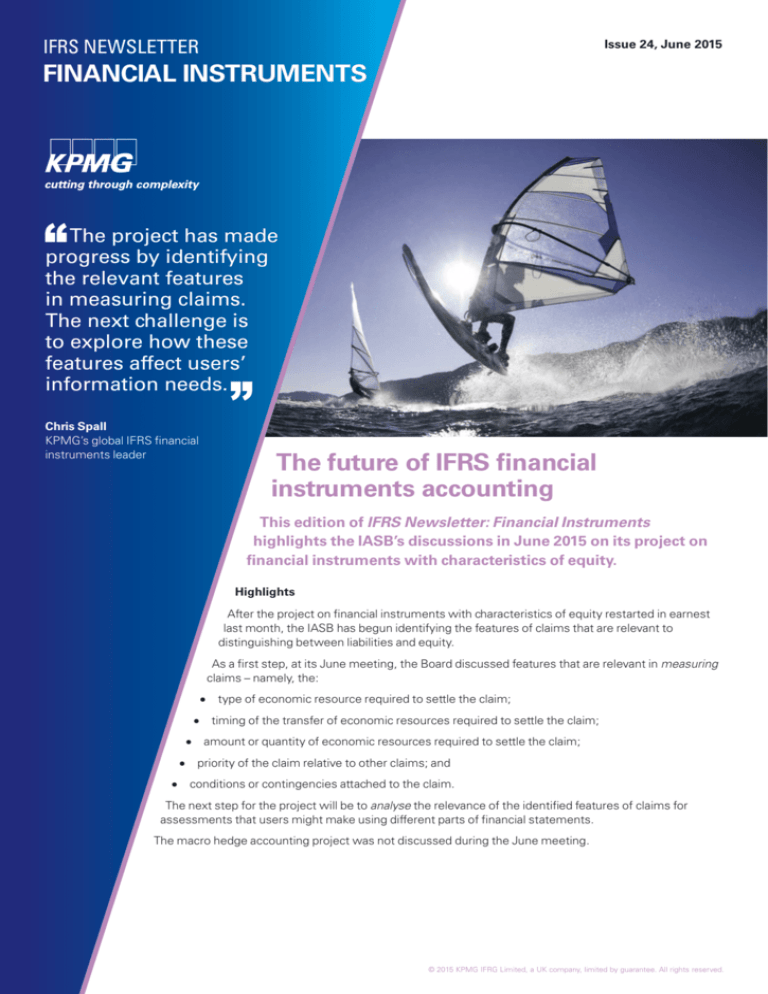
IFRS NEWSLETTER
Issue 24, June 2015
FINANCIAL INSTRUMENTS
The project has made
progress by identifying
the relevant features
in measuring claims.
The next challenge is
to explore how these
features affect users’
information needs.
Chris Spall
KPMG’s global IFRS financial
instruments leader
The future of IFRS financial
instruments accounting
This edition of IFRS Newsletter: Financial Instruments
highlights the IASB’s discussions in June 2015 on its project on
financial instruments with characteristics of equity.
Highlights
After the project on financial instruments with characteristics of equity restarted in earnest
last month, the IASB has begun identifying the features of claims that are relevant to
distinguishing between liabilities and equity.
As a first step, at its June meeting, the Board discussed features that are relevant in measuring
claims – namely, the:
l
l
l
l
l
type of economic resource required to settle the claim;
timing of the transfer of economic resources required to settle the claim;
amount or quantity of economic resources required to settle the claim;
priority of the claim relative to other claims; and
conditions or contingencies attached to the claim.
The next step for the project will be to analyse the relevance of the identified features of claims for
assessments that users might make using different parts of financial statements.
The macro hedge accounting project was not discussed during the June meeting.
© 2015 KPMG IFRG Limited, a UK company, limited by guarantee. All rights reserved.
FINANCIAL INSTRUMENTS WITH CHARACTERISTICS
OF EQUITY – RELEVANT FEATURES
The story so far …
IAS 32 Financial Instruments: Presentation includes requirements for the classification of financial
instruments between liabilities and equity. These binary classification requirements result in
significant practice issues when applied to many financial instruments with characteristics of
equity – other than, for example, typical non‑redeemable common shares that pay discretionary
dividends. In the past, the IFRS Interpretations Committee has received several queries in this
area and in some cases was unable to reach a conclusion. The Committee referred some of these
issues to the IASB, because the perceived issue required consideration of fundamental concepts
in IFRS.
The Board issued a discussion paper Financial Instruments with Characteristics of Equity in 2008.
However, due to capacity issues the Board could not issue an exposure draft on the topic and
the project was halted. Since then, the Board has discussed some of the challenges as part of its
project on the Conceptual Framework for Financial Reporting.
In October 2014, the Board resumed the project on financial instruments with characteristics of
equity, deciding to split the project into two work streams – classification, and presentation and
disclosures. The Board noted that the project may also result in amendments to the definitions of
liabilities and equity in the Conceptual Framework.
The Board did not formally revisit the project until May 2015, when it discussed the conceptual
and application challenges in distinguishing between liabilities and equity, and said that it would
identify the characteristics of claims that create these challenges as a next step in the project.
The staff
presented their
analysis of the
features of claims
that are relevant
to distinguishing
between liabilities
and equity.
What’s the issue?
The staff believe
that features are
only relevant if
they have the
potential to affect
the prospects for
future cash flows
on the claim.
What did the staff recommend?
The classification of financial instruments as liabilities or equity has a significant impact on their
balance sheet presentation, on their measurement, and on how they affect an entity’s financial
performance. However, the increasing complexity of financial instruments is making it difficult to
distinguish between liabilities and equity.
Now that the scope and the challenges of the project have been identified, the next important
step is to identify features of claims that are relevant to distinguishing between liabilities
and equity.
A claim that contains features that could affect the prospects for future cash flows should be
measured – through recognition or disclosure – to provide useful information about the claim.
Therefore, as a first step, the staff identified the features that are relevant in measuring claims –
i.e. those that affect the prospects for future cash flows.
A claim’s ‘features’ refer to the way it specifies the required transfer of economic resources1
– i.e. the circumstances under which the entity’s obligation will be settled. Examples of
settlements include:
• fulfilling the obligation;
• transferring economic resources to the holder by repurchasing the claim;
• negotiating a release from the claim; or
• replacing the existing claim with a new claim with different features.
1.
2
Under the proposed Conceptual Framework, an economic resource is a right that has the potential to produce
economic benefits.
© 2015 KPMG IFRG Limited, a UK company, limited by guarantee. All rights reserved.
Different features affect the prospects for future cash flows in different ways, and information about those effects may
influence different types of assessment that users make. These differences may require:
• different recognition requirements or measurement bases;
• inclusion of the amounts in different totals and subtotals in the balance sheet, and profit or loss; or
• additional information in the notes to the financial statements.
Relevant features identified by the staff
The staff believe that features are only relevant in measuring the aggregate amount of claims if they have the potential to affect
the prospects for future cash flows on the claim. The table below outlines five features that meet this criterion.
Examples of each type of
feature
How could the feature affect the
prospects for future cash flows?
How is the feature considered under current IFRS?
Type of economic resource required to settle the claim
Cash or other financial
assets.
Goods or services.
Any economic resources
under the control of the
entity.
• Allocates different types of
economic resource to different
claims.
• Introduces the risk that the
entity will not have the type of
economic resource required to
settle the claim.
• Determines whether any costs
incurred to produce, obtain or
convert economic resources
to settle a claim would flow to
other claim holders.
IFRS does not distinguish between liabilities and equity
on this basis. However, some IFRS requirements
are specific to the type of economic resource to be
transferred.
For example, IAS 39 Financial Instruments: Recognition
and Measurement (and IFRS 9 Financial Instruments)
and IAS 32 apply to “contractual obligations to deliver
cash or another financial asset to another entity”.
In addition, IAS 18 Revenue (and IFRS 15 Revenue from
Contracts with Customers) applies to the sale of goods
and the rendering of services.
Timing of the transfer of economic resources required to settle the claim (in full or in part)
Calendar dates for:
• full settlement – e.g.
maturity dates; and
• part settlement – e.g.
coupon payment dates.
• Determines whether the
transfer will take place before
the entity’s liquidation.
The timing of the transfer of economic resources is
implicit in the definition of liabilities, as illustrated by
the following standards.
• Allocates the entity’s economic
resources to claim holders at
different times.
Under IAS 32, obligations to transfer cash or other
financial assets before liquidation are financial
liabilities.
• Introduces the risk that the
entity will be unable to settle
the obligation when required.
Under IFRS 2 Share-based Payment, obligations
to transfer cash or other assets before liquidation
are liabilities.
• Determines whether any costs
incurred to produce, obtain or
convert economic resource
to settle a claim would flow to
those claims that are required
to be settled at a later time.
Under the proposed Conceptual Framework,
obligations to transfer economic resources before
liquidation are liabilities.
© 2015 KPMG IFRG Limited, a UK company, limited by guarantee. All rights reserved.
In addition, IAS 1 Presentation of Financial Statements
requires liabilities to be distinguished between current
and non-current (or, if elected, in the order of liquidity if
that is most relevant) on the balance sheet.
3
Examples of each type of
feature
How could the feature affect the
prospects for future cash flows?
How is the feature considered under current IFRS?
Amount or quantity of economic resources required to be transferred to settle the claim
Face values, coupons, floors
and/or ceilings denominated
in units of a selected
currency, commodity,
financial asset, or a basket
or index of assets.
• Identifies whether an obligation
exists to transfer a specified
amount or quantity of economic
resources, other than a pro rata
share of the entity’s remaining
economic resources.
These amounts may change
over time if:
• Allocates different quantities
or amounts of economic
resources to different claims.
• they are set with
reference to market
interest rates; or
• the economic resource
is denominated in units
of a selected currency,
commodity, financial
asset, or a basket or index
of assets.
• Introduces the risk that the
entity will not have the amount
of economic resource required
to settle the claim.
Some IFRS requirements specify the amount of
economic resources that are required to settle a claim.
IAS 32 states that “obligations to transfer a variable
number of equity instruments [equal to a specified
amount] are financial liabilities”.
IAS 33 Earnings per Share states that “the amount of
the preference dividends for cumulative preference
shares required for the period … is deducted from
profit or loss”.
One of the conditions of the puttable exception to the
definition of a financial liability in IAS 32 states that “the
total expected cash flows attributable to the instrument
over the life of the instrument are based substantially
on the profit or loss, the change in the recognised net
assets or the change in the fair value of the recognised
and unrecognised net assets of the entity over the life
of the instrument.”
Priority of the claim relative to other claims
Senior secured bonds.
Junior bonds.
Preference shares.
Common shares.
• Modifies the prospects for
future cash flows depending
on the relative ranking of the
claims (‘pecking order’ or
‘waterfall’).
Warrants.
Under IAS 32, puttable financial instruments that
include an obligation to transfer cash or other financial
assets before liquidation are classified as equity if
certain conditions are met.
Under IAS 33, ordinary shares – for which earnings
per share is calculated – are defined as an equity
instrument that is subordinate to all other classes of
equity instrument.
Conditions or contingencies attached to another particular feature – i.e. type, timing or amount – or to the claim as a
whole2
Unconditional.
Conditional on events within
the entity’s control.
Conditional on events within
the claim holder’s control.
Conditional on events
beyond the control of both.
• May lead to an obligation to
transfer economic resources:
– ceasing to exist in the future;
or
Some IFRS requirements – especially those related to
recognition and measurement – are specific to the type
of event on which the claim is contingent.
– being converted into a
different type of obligation
on the occurrence or nonoccurrence of a specified
event – e.g. as occurs for
written or purchased options
to issue claims.
2
For the purpose of this meeting, the staff analysed the relevant features independently – i.e. without considering their
interaction with one another. However, in practice they are analysed for their combined effects on claims.
2.
4
The staff will analyse and discuss conditions and contingencies in further detail in future IASB meetings.
© 2015 KPMG IFRG Limited, a UK company, limited by guarantee. All rights reserved.
How the staff would analyse claims with identified features
The information that the claim holders are interested in depends on the relevant features of claims – i.e. what affects the future
cash flows on the claim.
The holders of claims that contain all relevant features – e.g. ordinary bonds – are generally interested in information about the
type, timing, amount and uncertainty of future cash flows on the claims. These claim holders will also be interested in features
of other claims to the extent that they affect the future cash flows on their claims.
By contrast, the holders of claims that contain no relevant features – e.g. ordinary shares – are generally interested in
information about the entity’s economic resources and about any relevant features of other claims against the entity.
The staff considered some examples of simple claims, and whether they contain all, some or none of the relevant features
listed above.
Type of claim
Which relevant
features does it
contain?
Explanation
Ordinary bonds
All relevant features
The entity has an obligation to transfer an amount of cash, equal to an
amount specified in a particular currency, at a specified time before
liquidation and senior to all other claims.
Shares redeemable for
their fair value
Some relevant
features
The entity has an obligation to settle the claim, at fair value, at a specified
time before liquidation or on demand of the holder with cash.
However, like ordinary shares (see below), they do not specify the
amount of economic resources and claims that the entity needs to pay
– i.e. the fair value of the ordinary shares reflects the total amount of
recognised and unrecognised economic resources and other claims.
These claims do not require the entity to settle the claim using economic
resources – i.e. the entity uses a variable number of its own ordinary
shares instead of cash. Also, these claims are not required to be settled
before liquidation of the entity (although conversion to a claim with
different features is required before liquidation).
Share-settled debt
However, like ordinary bonds, they specify the amount or rate of change
in amount that the entity requires to settle the claims.
These claims are not required to be settled before liquidation of the entity.
Cumulative preference
shares
Ordinary shares
However, like ordinary bonds, they specify the amount or rate of change
in amount that the entity requires to settle the claims.
No relevant features
The entity has no obligation to transfer any amount or any specific type
of economic resources to the holders of ordinary shares until the entity’s
liquidation.
KPMG Insight
The notion that ordinary shares do not have relevant features means that the prospects for future cash flows on such
instruments are primarily driven by the entity’s overall economic resources – i.e. its ability to generate cash flows – and the
cash flows that will be required to settle other claims – i.e. claims with relevant features that have a priority over ordinary
shares. This appears indicative of ordinary shares representing a residual or equity-like interest.
© 2015 KPMG IFRG Limited, a UK company, limited by guarantee. All rights reserved.
5
Features that the staff do not believe are relevant
The staff believe that the following features, which have been suggested as criteria over the years, are not relevant to assessing
prospects for future cash flows of the claim (or do so only as a result of features that are relevant).
What is it?
Why is it not relevant?
Rights affecting the entity’s economic resources
This feature may specify
voting rights or restrictive
rights over the entity’s
activities – e.g. rights to vote
at shareholder meetings, and
debt covenants.
Such rights may affect the entity’s economic resources and the prospects for their future
cash flows. However, they do not affect how those prospects are allocated amongst
claims.
Information about the nature and amount of economic resources is provided through the
recognition and measurement requirements applying to the entity’s assets.
Furthermore, if claim holders have control over the entity, then they have the power to
demand information about the entity and are not the primary users of financial statements.
Risk of returns on claims
This is a measure of the
uncertainty of the prospects
for future cash flows on a
claim.
This feature may influence different types of assessment that users need to make, and
therefore a desired outcome of classification may be to depict claims that have similar
risk together. However, to achieve this outcome the features would need to be specified –
which is not the case for this measure.
Perspective of financial reporting
Financial statements
are presented from the
perspective of the entity, not
its capital providers.
This feature is relevant in meeting the objective of financial reporting – i.e. financial
statements should provide information that:
• is useful to existing and potential investors, lenders and other creditors; and
• focuses on these parties’ common information needs.
KPMG Insight
The staff’s argument that the feature relating to voting or restrictive rights over the entity’s economic activities is not
relevant does not necessarily mean that it is also irrelevant to determining the value of a claim. For example, a debt
instrument that is supported by covenants may have more value than one that is not supported by covenants. However,
the additional value derives from the interaction of the covenant with the relevant other terms of the instrument – e.g.
requirements for payment of principal and interest. Also, shares with voting rights might have a higher market value than
shares without voting rights.
What did the IASB discuss?
The Board did not make any decisions during this meeting. However, Board members agreed with the features identified by
the staff.
During the discussion, one Board member confirmed with the staff that the features identified relate to the measurement of
claims, without considering their allocation between different classes of liabilities and equity.
The member also clarified with the staff that – although the perspective of financial reporting is not a relevant feature for the
direct measurement of claims – it is likely to become a relevant feature in considering the assessments made by users.
6
© 2015 KPMG IFRG Limited, a UK company, limited by guarantee. All rights reserved.
YOU MAY ALSO BE INTERESTED TO READ …
Visit KPMG’s Global IFRS Institute at kpmg.com/ifrs to access KPMG’s most recent publications on the IASB’s major projects
and other activities.
Insights into IFRS: Volume 3 – IFRS 9 (2014)
First Impressions: IFRS 9 Financial Instruments
Builds on previous publications to
bring you our first complete work
of interpretative guidance based on
IFRS 9 (2014).
Provides our detailed analysis on
the complete version of IFRS 9
Financial Instruments.
September 2014
April 2015
IFRS Newsletter: IFRS 9 Impairment – Issue 1
Guide to annual financial statements –
Illustrative disclosures for banks
Highlights the discussions of the
IFRS Transition Group for Impairment
of Financial Instruments on the
impairment requirements of IFRS 9.
Illustrates one possible format
for financial statements based
on a fictitious bank and helps to
identify which disclosures may
be required.
April 2015
December 2014
IFRS Newsletter: Revenue – Issue 13
IFRS Newsletter: Insurance – Issue 45
Examines the latest developments
on the new revenue standard.
Summarises the IASB’s recent
discussions on the insurance
contracts project.
March 2015
May 2015
IFRS Newsletter: Leases – Issue 17
Highlights the recent discussions
of the IASB and the FASB on their
lease accounting proposals published
in 2013.
Breaking News
Brings you the latest need-toknow information on international
standards in the accounting, audit
and regulatory space.
March 2015
© 2015 KPMG IFRG Limited, a UK company, limited by guarantee. All rights reserved.
7
KPMG CONTACTS
Americas
Michael Hall
T: +1 212 872 5665
E: mhhall@kpmg.com
Asia-Pacific
Reinhard Klemmer
T: +65 6213 2333
E: rklemmer2@kpmg.com.sg
Europe, Middle East and Africa
Colin Martin
T: +44 20 7311 5184
E: colin.martin@kpmg.co.uk
Tracy Benard
T: +1 212 872 6073
E: tbenard@kpmg.com
Toshihiro Ozawa
T: +81 3 3548 5107
E: toshihiro.ozawa@jp.kpmg.com
Venkataramanan Vishwanath
T: +91 22 3090 1944
E: vv@kpmg.com
Acknowledgements
We would like to acknowledge the efforts of the principal author of this publication: Sandeep Patkar.
We would also like to thank Chris Spall for his review and input.
© 2015 KPMG IFRG Limited, a UK company, limited by guarantee. All rights reserved.
KPMG International Standards Group is part of KPMG IFRG Limited.
Publication name: IFRS Newsletter: Financial Instruments
Publication number: Issue 24
Publication date: June 2015
The KPMG name, logo and “cutting through complexity” are registered trademarks or trademarks of KPMG International.
KPMG International Cooperative (“KPMG International”) is a Swiss entity that serves as a coordinating entity for a network of
independent firms operating under the KPMG name. KPMG International provides no audit or other client services. Such services
are provided solely by member firms of KPMG International (including sublicensees and subsidiaries) in their respective geographic
areas. KPMG International and its member firms are legally distinct and separate entities. They are not and nothing contained
herein shall be construed to place these entities in the relationship of parents, subsidiaries, agents, partners, or joint venturers. No
member firm has any authority (actual, apparent, implied or otherwise) to obligate or bind KPMG International or any other member
firm, nor does KPMG International have any such authority to obligate or bind KPMG International or any other member firm, in any
manner whatsoever.
The information contained herein is of a general nature and is not intended to address the circumstances of any particular individual
or entity. Although we endeavour to provide accurate and timely information, there can be no guarantee that such information is
accurate as of the date it is received or that it will continue to be accurate in the future. No one should act upon such information
without appropriate professional advice after a thorough examination of the particular situation.
The IFRS Newsletter: Financial Instruments contains links to third party websites not controlled by KPMG IFRG Limited. KPMG
IFRG Limited accepts no responsibility for the content of such sites or that these links will continue to function. The use of third party
content is to be governed by the terms of the site on which it is hosted and KPMG IFRG Limited accepts no responsibility for this.
Descriptive and summary statements in this newsletter may be based on notes that have been taken in observing various Board
meetings. They are not intended to be a substitute for the final texts of the relevant documents or the official summaries of Board
decisions which may not be available at the time of publication and which may differ. Companies should consult the texts of any
requirements they apply, the official summaries of Board meetings, and seek the advice of their accounting and legal advisors.
kpmg.com/ifrs
IFRS Newsletter: Financial
Instruments is KPMG’s
update on the IASB’s financial
instruments project.
If you would like further
information on any of the matters
discussed in this Newsletter,
please talk to your usual local
KPMG contact or call any of
KPMG firms’ offices.

